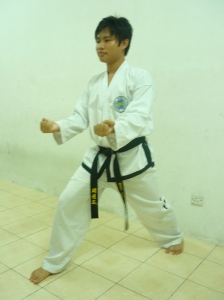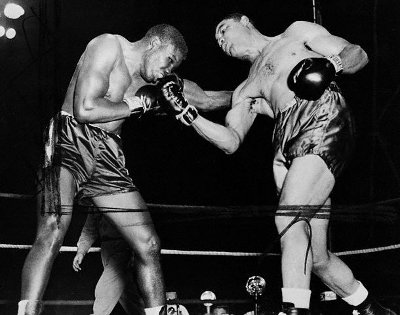Making the Taekwondo Upset Punch less Upsetting
Alright, I'll go on record to say there's no one 'right' way to throw a punch. If you see an opening, swing your hand, manage to hit the opponent where you wanted to hit him and not break your hand in the process, hey ... congratulations.
But I do reckon that there are ways to do a punch better. Last night we did some close quarter drills which included the 'upset' punch. In our system, we have the first upset punch in Step 15 of Choong-gun. Yeah, yeah, yeah ... that's not how you do your form. Well that's how we do our form - we do a mid yop marki in Step 14, a circular grab and upset punch punch in Step 15 and then a punch in Step 16. While we don't apply it as such, that's the way we perform it in the pattern.
So anyway, back to our session - here we are with the drill and we're getting students to control their opponent's elbows, drag the cover out of the way, and then punch generously into their opponent's lats. This way you don't have to hold back too much and people don't get too bruised. Except what I'm seeing from my vantage point is people standing stock still, and moving their arms back and forth like Popeye. Actually even Popeye supports the strike with good body movement.
What I don't want to see is an arm disconnected from the body. The arm is disconnected from the body when it is held so loosely that there's minimal shoulder involvement, the movement is driven mostly by arm power and there's little body rotation supporting the strike.
Look at the above boxing picture, the uppercut has the body rotating upwards into the opponents face. The strike comes upward through an opponent, and the elbow is held low so that the mass of the upper body can be sent through the arm into the striking weapon. We mostly achieve a facsimile of this in the form whilst our bodies are upright by bringing the elbow close to the body and tightening our lats. This means that the forward motion of the body can 'connect' with the arm and you are hitting with more than the 5 or so kilos that the arm weighs.
 |
| Hmm... I'm not too sure about this guy's upset punch. |
I don't really like to overly criticize other practitioners, but the picture above shows an example of a twin fist upset punch performed done not too differently from how my students were faring last night. The guy's lats don't seem to offer enough stability to the arm, the strike seems a little over extended, and the strike also seems to be traveling in a trajectory outside the body's shoulder frame. I would also recommend angling the strike upwards, if indeed this was performed as a strike. Of course if you were saying it's really supposed to be a takedown, hey, just ignore what I'm saying. Or better yet, associate it with some secret pressure point skill that I'm not privvy to.
My top tips to make the punch work for you is to support the strike with your body, to keep the elbow close to your lats, and to angle the strike upwards. If the arms leaves the body and is swung using some shoulder muscle, that does not help optimise the drive your body can create. And if you don't tighten the arm to your frame using your lats/pecs, then you are not maximising the power you can apply into the target. The interesting thing is that the arm doesn't move all that much in relation to the body - meaning if you get the body to move with the arm and decelerate the arm upon impact, that can make for a really solid strike. Check out this kyokushin video.
While the arm is not yet extended and when you strike something at such a range, the impact area is the 'box' of the hand, i.e. the lower three knuckles as opposed to the two knuckles used in lunging strikes (with the hand rotated and palm facing downward). If you apply the 'hard weapon to soft target and soft weapon to hard target' rule of thumb, sending this typically untrained part of the hand into the opponent should not reduce it's ability to apply a good amount of power.
--
[ Traditional Taekwondo Perth | Testimonials | YouTube | Subscribe | Sitemap ]
Please support us by liking our Traditional Taekwondo Blog's FB page click here
Come play with us ...
- Make basic blocks part of an indispensable close quarter toolkit!
- Breathe life into your line drill.
- Integrate easy throws into a hard style syllabus.
- Endow simple kicks with (more) stopping power.
- Tap into martial philosophy & etiquette to get you into the zone.
- Taekwondo pattern applications show the form is not there to limit you!
- We welcome all styles, all ranks, and especially welcome open-minded practitioners.
- Happy to also ditch training and just hang out.
We are located in Perth, Western Australia. But if you can't make it to us ...
Travel itinerary for our black belts in 2020/1 include but not limited to:
USA, Melbourne, Singapore, Manila, and Germany. Please inquire.
To avoid embarrassment, please do not inquire about certification through JDK. Additionally, please do not offer certification as a token of appreciation to any JDK member.
We are located in Perth, Western Australia. But if you can't make it to us ...
Travel itinerary for our black belts in 2020/1 include but not limited to:
USA, Melbourne, Singapore, Manila, and Germany. Please inquire.
To avoid embarrassment, please do not inquire about certification through JDK. Additionally, please do not offer certification as a token of appreciation to any JDK member.


